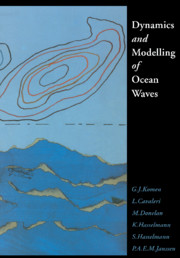Book contents
- Frontmatter
- Contents
- Contributors
- Preface
- Chapter I Basics
- Chapter II The physical description of wave evolution
- Chapter III Numerical modelling of wave evolution
- Chapter IV Applications to wave hindcasting and forecasting
- Chapter V Global satellite wave measurements
- Chapter VI Wave data assimilation and inverse modelling
- Chapter VII Summary and outlook
- Members of the WAM group
- Affiliations and addresses of contributors
- Notation and abbreviations
- References
- Index
Preface
Published online by Cambridge University Press: 22 January 2010
- Frontmatter
- Contents
- Contributors
- Preface
- Chapter I Basics
- Chapter II The physical description of wave evolution
- Chapter III Numerical modelling of wave evolution
- Chapter IV Applications to wave hindcasting and forecasting
- Chapter V Global satellite wave measurements
- Chapter VI Wave data assimilation and inverse modelling
- Chapter VII Summary and outlook
- Members of the WAM group
- Affiliations and addresses of contributors
- Notation and abbreviations
- References
- Index
Summary
De uiterlijke eigenheden der zee, de kleuren en de verschillende golfvormen en de wijze waarop de grote baren omslaan, kokend aanbruisen, schuim-betijgerd uitzwalpen en zich terugslepen van 't vlakke zand – die herdacht zij en minde zij zoals een minnaar de trekken en gebaren van zijn geliefde herdenkt en mint.
Frederik van Eeden, Van de koele meren des doods, 1900Those were the waves my friend …
The beginning
In the spring of 1984 Klaus Hasselmann invited wave modellers to Hamburg to discuss possible joint work. The WAM (Wave Modelling) group emerged. I dutifully reported on progress (Komen, 1985a,b, 1986, 1987a,b, 1990, 1991a,b). Now, ten years later, the WAM group has achieved what it wanted to achieve: a third generation computer model has been developed, which is able to predict the wave conditions at sea; it is used for global and regional applications; the model is a useful tool for interpreting satellite observations of the ocean and increased our understanding of the role of waves in air/sea interaction and the coupling between the atmosphere and the ocean. The results obtained are presented in this book.
WAM was one of a number of international collaborations: JONSWAP, SWAMP, SWIM, WAM, … Observations during the Joint North Sea Wave Project (Hasselmann et al, 1973) and also by Mitsuyasu and collaborators (Mitsuyasu, 1966, 1969, Mitsuyasu et al, 1971) had established the importance of the nonlinear transfer in governing the shape and evolution of a wind sea spectrum. Based on this finding ‘parametric’ wave models had been developed based on the approximation of a self-similar shape of the wind-sea spectrum.
Information
- Type
- Chapter
- Information
- Dynamics and Modelling of Ocean Waves , pp. xiii - xxiiPublisher: Cambridge University PressPrint publication year: 1994
